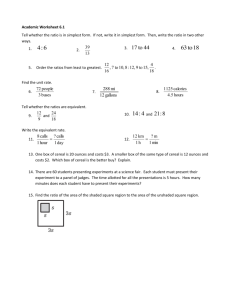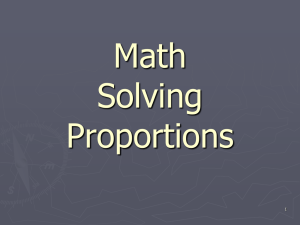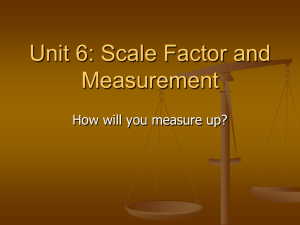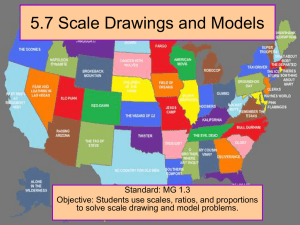Ratios and Proportions
advertisement
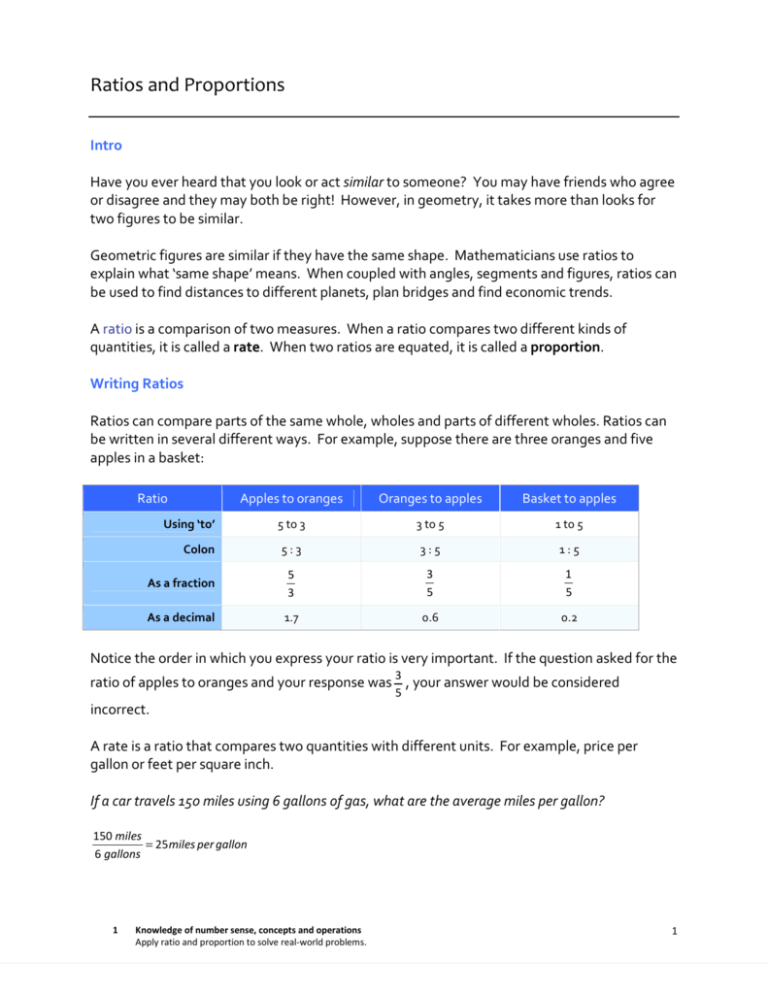
Ratios and Proportions Intro Have you ever heard that you look or act similar to someone? You may have friends who agree or disagree and they may both be right! However, in geometry, it takes more than looks for two figures to be similar. Geometric figures are similar if they have the same shape. Mathematicians use ratios to explain what ‘same shape’ means. When coupled with angles, segments and figures, ratios can be used to find distances to different planets, plan bridges and find economic trends. A ratio is a comparison of two measures. When a ratio compares two different kinds of quantities, it is called a rate. When two ratios are equated, it is called a proportion. Writing Ratios Ratios can compare parts of the same whole, wholes and parts of different wholes. Ratios can be written in several different ways. For example, suppose there are three oranges and five apples in a basket: Ratio Apples to oranges Oranges to apples Basket to apples 5 to 3 3 to 5 1 to 5 5:3 3:5 1:5 As a fraction 5 3 3 5 1 5 As a decimal 1.7 0.6 0.2 Using ‘to’ Colon Notice the order in which you express your ratio is very important. If the question asked for the 3 5 ratio of apples to oranges and your response was , your answer would be considered incorrect. A rate is a ratio that compares two quantities with different units. For example, price per gallon or feet per square inch. If a car travels 150 miles using 6 gallons of gas, what are the average miles per gallon? 150 miles = 25 miles per gallon 6 gallons 1 Knowledge of number sense, concepts and operations Apply ratio and proportion to solve real-world problems. 1 Proportions Two ratios set equal to each other are called a proportion. Suppose you are baking a cake for a party of six people, the ingredients specify for 2 ounces of baking soda. You later realize more people are attending your party. In order to figure out how much more baking soda you need, you create a proportion to find the new amount. For example: Ingredients for six people 2 ounces baking soda 4 cups of milk 2 eggs 1 tsp salt 4 cups of flour 2 cups of sugar If 10 people show up, how much more baking soda do you need for your cake? If x = amount of baking soda, then amt of baking soda 2 ounces x ⇒ = . amt of people 6 people 10 people Now, you can probably work through this problem in your head. However, there is a property we can use when the numbers get more complex. Proportion Property To show that one ratio a c a c is equal to another ratio , you can write the proportion = . b d b d In order to solve a proportion for one of the variables (e.g., a, b, c or d), you use the CrossProduct property. a b c d If you have a proportion = , then ad=bc. So, using the cross-product for our previous example, 2 ounces x ounces = 6 people 10 people 20 = 6 x (using the cross-product property) 10 =x 3 (dividing both sides by 6 to isolate x) 1 3 = x (rewrite as a mixed fraction) 3 1 3 Therefore, you would need 3 ounces of baking soda for a cake for 10 people. 1 Knowledge of number sense, concepts and operations Apply ratio and proportion to solve real-world problems. 2 Example 2: The following rectangles are similar. The corresponding sides of the rectangles are proportional. Find the missing length. 3ft 7ft 5ft ?ft Solution To find the missing length, we can write the proportion: width 3 ft 7 ft ⇒ = length 5 ft ? Using the Cross-Product property, 3 = 7 5 x 3 x = 35 x= (divide both sides by 3 to isolate the x) 35 2 or 11 3 3 2 3 The missing length is 11 feet . Example 3: You go to Kinko’s® to enlarge an original picture. What are the dimensions of an 8-inch by 10inch rectangular picture that is enlarged by 130%? Solution Since we want to find two dimensions, namely a width and a length, we can set up two proportions. 1 Knowledge of number sense, concepts and operations Apply ratio and proportion to solve real-world problems. 3 To find the length: Let x represent the length of the enlarged picture. New length Original length x 130 = 10 100 Size of enlargement Original size 100 x = 10(130) Cross-product property 100 x = 1300 Multiply right side. x = 13 Divide both sides by 100 to isolate x. The length of the enlargement is 13 inches. Let y represent the width of the enlarged picture. New width Original width y 130 = 8 100 Size of enlargement Original size 100y = 130(8) Cross-product property 100y = 1040 Multiply right side. y = 10.4 Divide both sides by 100 to isolate x. The width of the enlargement is 10.4 inches. Did you know… Even though a ratio and a fraction look the same, they are different! A fraction compares a part of a whole, so it can be a ratio. BUT, a ratio does not necessarily have to be a fraction. A ratio can compare a part of another part or compare two wholes which can make a great difference when you try to compute. 1 Knowledge of number sense, concepts and operations Apply ratio and proportion to solve real-world problems. 4



